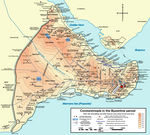Fall of Constantinople

The Fall of Constantinople was the capture of the capital of the Byzantine Empire by the Ottoman Empire. The city fell on 29 May 1453, the culmination of a 53-day siege which had begun on 6 April 1453. The attacking Ottoman Army, which significantly outnumbered Constantinople's defenders, was commanded by the 21-year-old Sultan Mehmed II (later called "Mehmed the Conqueror"), while the Byzantine army was led by Emperor Constantine XI Palaiologos. After conquering the city, Mehmed II made Constantinople the new Ottoman capital, replacing Adrianople. The conquest of Constantinople and the fall of the Byzantine Empire was a watershed of the Late Middle Ages and is considered the end of the medieval period. The city's fall also stood as a turning point in military history. Since ancient times, cities and castles had depended upon ramparts and walls to repel invaders. The Walls of Constantinople, especially the Theodosian Walls, were some of the most advanced defensive systems in the world. These fortifications were overcome with the use of gunpowder, specifically in the form of large cannons and bombards, heralding a change in siege warfare.
Excerpt from the Wikipedia article Fall of Constantinople (License: CC BY-SA 3.0, Authors, Images).Fall of Constantinople
Kennedy Avenue, Istanbul
Geographical coordinates (GPS) Address Website Nearby Places Show on map
Geographical coordinates (GPS)
| Latitude | Longitude |
|---|---|
| N 41.0167 ° | E 28.9769 ° |
Address
Sirkeci-1 İsbike İstasyonu
Kennedy Avenue
34110 Istanbul
Türkiye
Open on Google Maps








